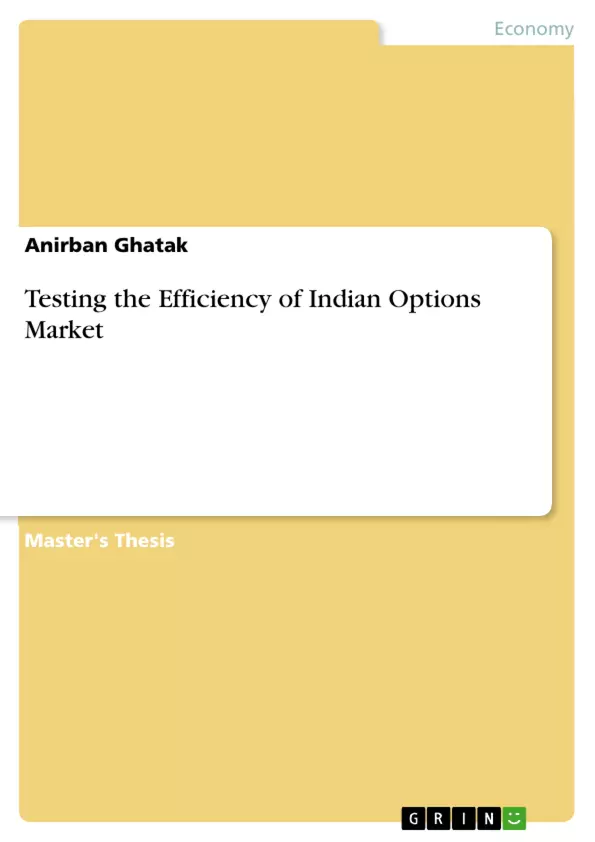The present study is conducted to test the efficiency of Indian options market. Very few studies have been conducted to test the efficiency of Indian derivatives market and especially Indian options market. This study is essential for testing the price discovery of the Indian options market. This study is motivated by lack of evidence and fills this gap by providing hitherto unavailable evidence on efficiency of the Indian options market.
The purpose of the study is to test the efficiency of Nifty stock options. The study is done using trading data for 1 month. Market efficiency is tested by examining the validity of the put-call parity and of the hedging strategy. Black-Scholes model of option pricing is used to determine the fair option prices in this study. In case of mispricing of options contracts, hedging test is conducted to ascertain whether above normal returns are possible by taking advantage of the mispricing.
In hedging test returns are calculated after the trader closes his position in the spot market. These returns are then compared to risk-free returns. When transaction costs are not taken into account, the hedging returns were more than the risk free returns for some stocks which showed that the market is inefficient. But after transaction costs are considered these returns became negative and ascertained that the market is efficient. Put-call parity test in the absence of the transaction costs showed that options market is inefficient. However in the presence of these costs, the hypothesis of market efficiency is accepted.
The present study will help to get useful insights so that the options markets can be made more efficient as healthy financial markets are backbone of any financially healthy country. Furthermore, financial markets should be efficient and efficiency helps to prevent any kind of frauds in the financial markets.
Inhaltsverzeichnis (Table of Contents)
- CHAPTER I
- INTRODUCTION
- GENESIS OF THE PROBLEM
- MAJOR CONCEPTS
- NEED FOR THE STUDY
- OVERVIEW
- CHAPTERIZATION
- CHAPTER II
- REVIEW OF LITERATURE
- INTRODUCTION
- HOW REVIEW HAS BEEN CONDUCTED
- STUDIES CONDUCTED ABROAD
- STUDIES CONDUCTED IN INDIA
- CHAPTER III
- RESEARCH METHODOLOGY
- INTRODUCTION
- STATEMENT OF THE PROBLEM
- METHODOLOGY
- VARIABLES USED
- HYPOTHESES
- SAMPLE SIZE
- SOURCES OF THE DATA
- SAMPLING TECHNIQUE
- TESTS USED IN THE STUDY
- CHAPTER IV
- INDUSTRY OVERVIEW
- INTRODUCTION
- OVEVIEW OF DERIVATIVES MARKET IN INDIA
- GLOBAL DERIVATIVES MARKET
- POLICY DEVELOPMENTS IN INDIA
- CHAPTER V
- DATA ANALYSIS AND INTERPRETATION
- INTRODUCTION
- SECONDARY DATA ANALYSIS
- CHAPTER V
- FINDINGS, CONCLUSION AND SUGGESTIONS
- INTRODUCTION
- DISCUSSION OF RESEARCH FINDINGS
Zielsetzung und Themenschwerpunkte (Objectives and Key Themes)
This study investigates the efficiency of the Indian options market, focusing specifically on Nifty stock options. The research aims to fill a gap in existing literature by providing evidence on the market's efficiency through analysis of trading data. This analysis will contribute to understanding the effectiveness of price discovery and the potential for profit opportunities in the Indian options market.
- Assessing the efficiency of the Indian options market
- Examining the validity of the put-call parity and hedging strategies in the Indian options market
- Utilizing the Black-Scholes model to determine fair option prices
- Evaluating the impact of transaction costs on market efficiency
- Providing insights to enhance the efficiency of the Indian options market
Zusammenfassung der Kapitel (Chapter Summaries)
Chapter I introduces the study, defining the research problem and outlining the need for its investigation. Chapter II reviews existing literature, exploring previous studies both domestic and international. Chapter III outlines the research methodology, including the specific research problem, data sources, and statistical tests used. Chapter IV provides an overview of the derivatives market in India, encompassing the global market and policy developments. Chapter V presents the findings of the research, incorporating the results of the put-call parity test and the hedging analysis. Chapter VI concludes the study by discussing the main findings, providing suggestions for improvement, and highlighting the limitations of the research.
Schlüsselwörter (Keywords)
The core concepts explored in this study include options market efficiency, price discovery, put-call parity, hedging strategy, Black-Scholes model, transaction costs, and the Indian derivatives market. The study focuses on analyzing the efficiency of the Indian options market, specifically through the lens of Nifty stock options.
- Citation du texte
- Anirban Ghatak (Auteur), 2014, Testing the Efficiency of Indian Options Market, Munich, GRIN Verlag, https://www.grin.com/document/454881



